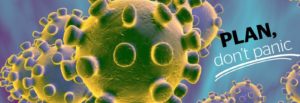
Indiana Governor Eric Holcomb’s weekly news conference, November 18, was led by Dr. Kristina Box, Indiana’s State Health Commissioner, as the Governor and his wife quarantine at home per COVID-19 guidelines. Several members of his security detail tested positive for COVID the day before. While neither the Governor nor his wife have symptoms, they have participated in contact tracing and will get tested later in the week. Dr. Box recommends getting tested 48 hours from the first sign of positive symptoms in a close contact.
Cases are rising dramatically in Indiana and across the Midwest. Twenty-one counties are now in red (level 4) on Indiana’s COVID-19 dashboard map. Fayette County, which was in the red the past two weeks, was back to orange (Level 3) as of November 18. Wayne and surrounding counties are all orange, even though Wayne County’s positivity rate is seeing an upward trend.
The news conference focused heavily on reports from hospital leaders from across the state. Each leader explained the toll the pandemic is taking on hospital employees.
– Employees are serving frontline roles as healthcare providers, friends, and confidants to COVID patients. It is becoming more common that a hospital employee is the only one present to support dying patients. Due to the surge, many hospitals are again implementing visit restrictions.
– Hospitals are utilizing staff from every area of the hospital to be on the front line with patients because of staff shortages. The shortages result from a variety of factors. Staff members that have been exposed to COVID or infected themselves, taking them out of service. There are also employees whose children are forced into virtual schooling. Burnout is causing large numbers of the people to leave the healthcare workforce. And, mental and physical exhaustion are also taking a toll on healthcare workers who see no break in cases.
– While nursing shortages were a problem before the pandemic, hospitals were able to rely on contract and traveling employees to fill temporary shortages. Now, the entire Midwest is now competing for the limited healthcare workforce.
– The amount of sickness and death healthcare workers are seeing during the pandemic is not normal and will have an emotional impact for years to come.
An overarching theme of this press conference included concern about the Thanksgiving holiday, and an already overwhelming virus surge becoming even stronger. Families are encouraged to look at the holidays differently this year, limiting visitors and taking extra safety precautions.
Suggestions for holiday entertainment in 2020 include:
– Celebrate with a small immediate family group.
– Prepare recipes and deliver them in a way that does not involve close contact.
– Set expectations up front, that everyone needs to follow, such as self screening for symptoms prior to gathering; staying home if you’re sick; having hand sanitizer on tables that is used often; frequently cleaning high touch surfaces; letting fresh air in by opening blinds and windows; using hepa air filters; and especially wearing masks except when eating.
– When housing people overnight, have separate bedrooms and bathrooms for guests.
– It is strongly recommended to not take anyone out of a long-term care facility at this time.
Dr. Box reminded Hoosiers there will be “more than 5,000 empty seats across Indiana this year because of COVID.” Suggestions for reducing contacts and visits during this holiday season are in place so we can enjoy many future celebrations together, without missing anyone.
Indiana is preparing for the arrival of vaccines and expects Pfizer’s to arrive first. Dr. Lindsay Weaver, ISDH Chief Medical Officer, said the Pfizer vaccine should arrive in the states within 48 hours after the Emergency Use Authorization (EUA) is granted. Dr. Weaver emphasized this vaccine has not been rushed as it was developed based on research that has been ongoing for the past decade. The first allocation will be for frontline healthcare workers with direct exposure to patients or COVID materials. Dr. Weaver believes it will be late Spring to early summer before vaccines are readily available to the public.
Additional information about the vaccine distribution plan may be found at https://www.coronavirus.in.gov/ under the Public Resources tab which contains a link to the COVID-19 Vaccine Allocation Draft Plan.
